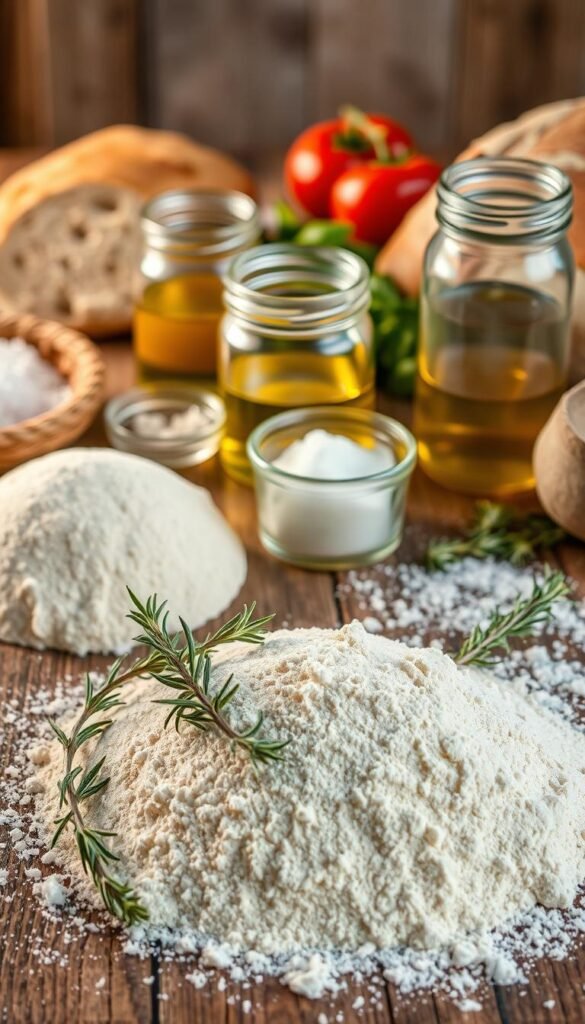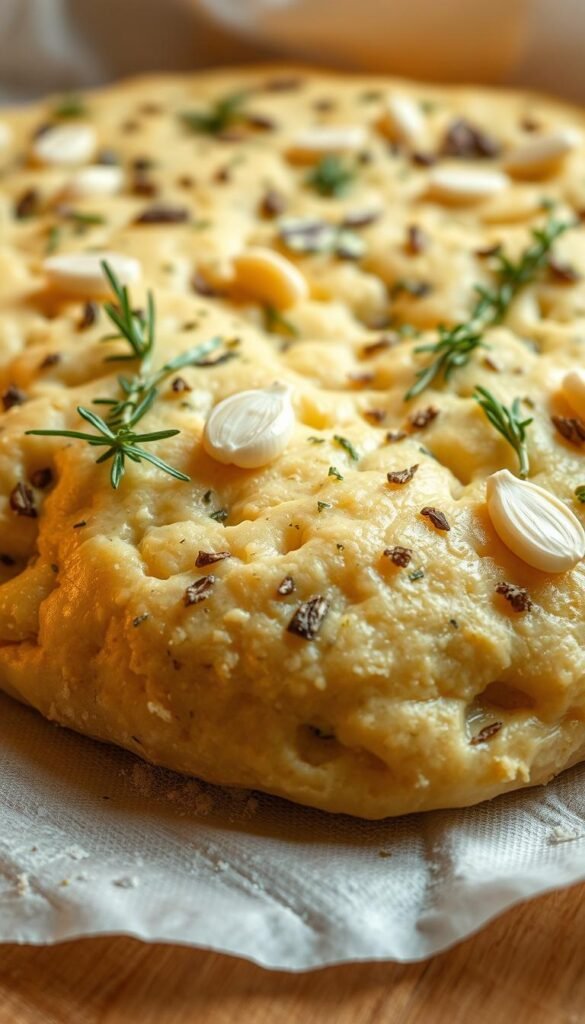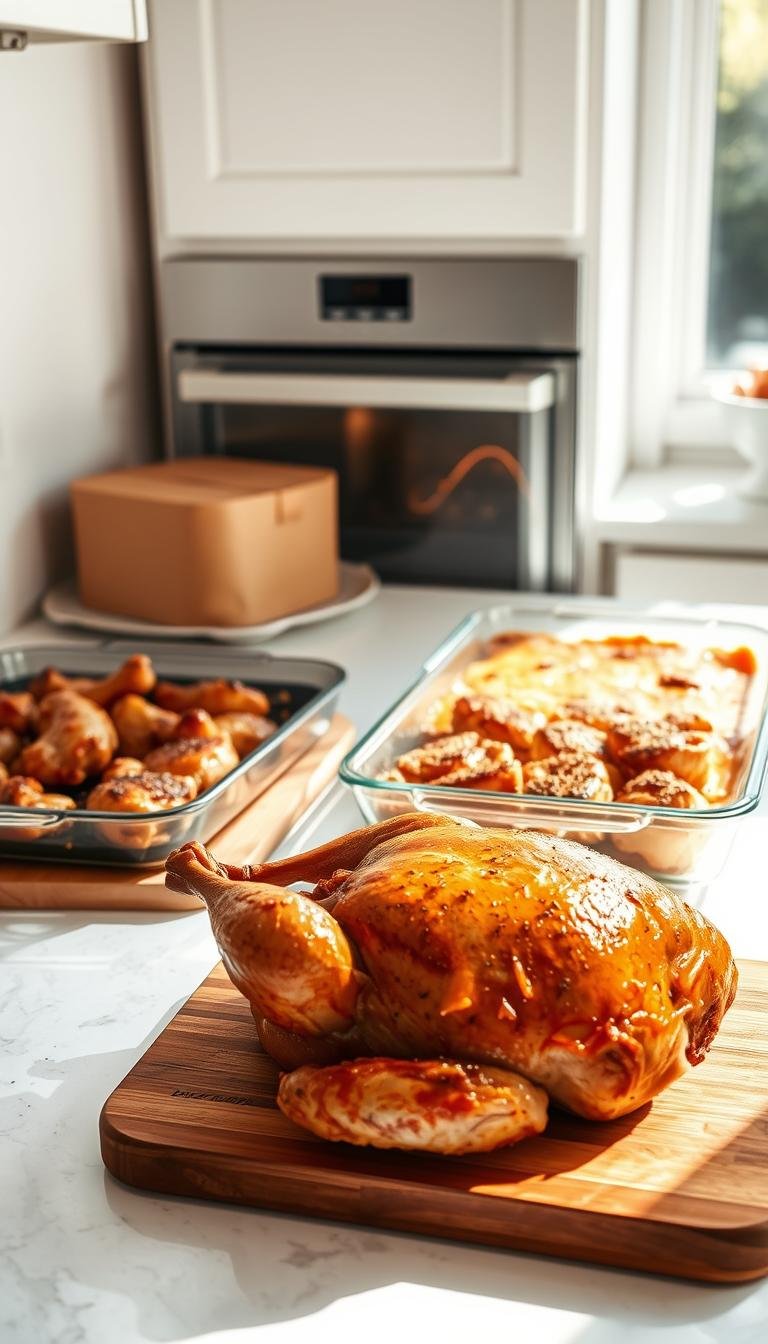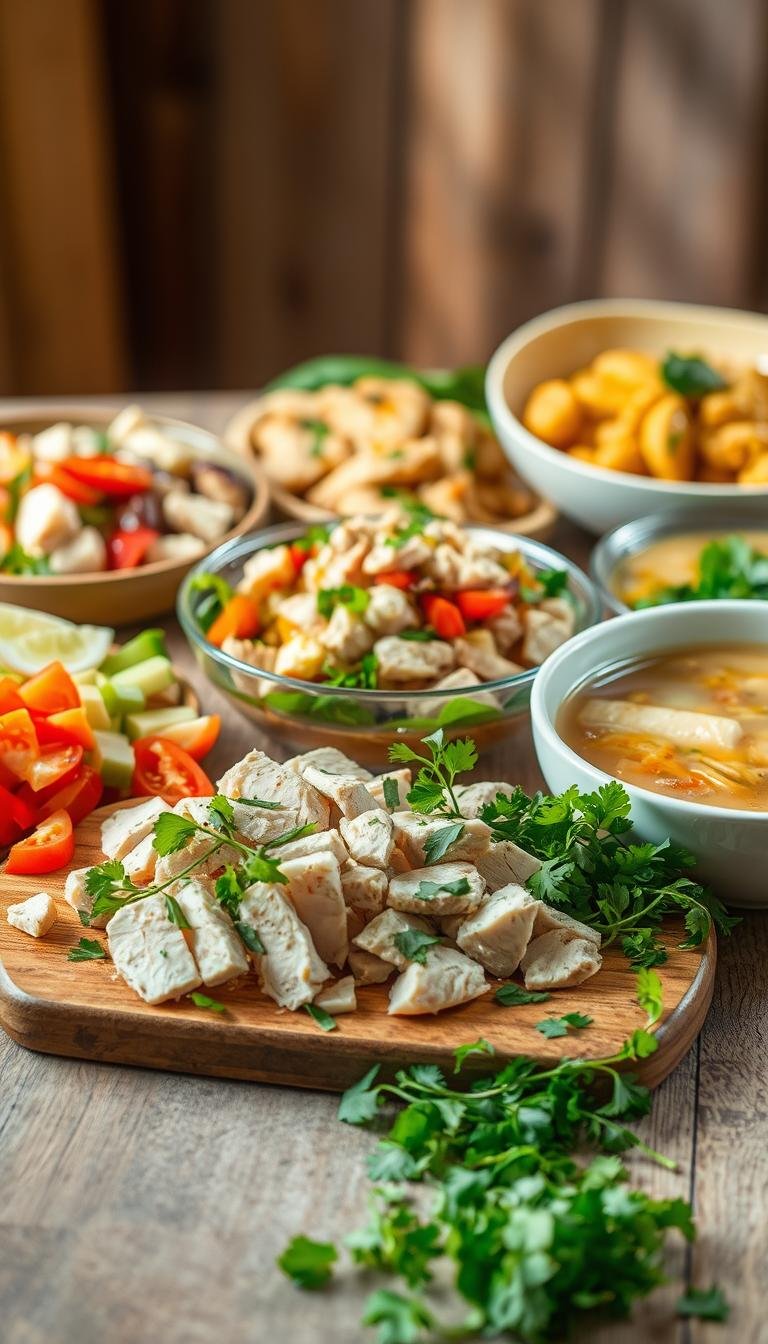5 Foolproof Focaccia Bread Recipes You Need to Try This Weekend
Freshly baked focaccia is a treat that can elevate any meal, and with the right recipes, it’s easier to achieve than you think. Did you know that focaccia is one of the most versatile Italian breads, perfect for dipping, sandwich-making, or serving alongside your favorite soups and salads?
Making homemade focaccia can be a fun and rewarding weekend baking project. With these exceptional Italian bread recipes, you’ll be able to create delicious focaccia with various toppings and flavors. Whether you’re a beginner or an experienced baker, these easy focaccia recipes are designed to be foolproof, ensuring you achieve perfect results every time.
Key Takeaways
- Discover 5 exceptional focaccia recipes perfect for weekend baking.
- Learn how to make traditional Italian-style focaccia and creative variations.
- Develop basic baking skills and understand the time commitment required.
- Explore different toppings and flavors to elevate your focaccia game.
- Enjoy freshly baked focaccia as a side dish, sandwich bread, or snack.
The Art of Focaccia: A Brief History and Overview
This traditional Italian flatbread has a fascinating history that began over 2,000 years ago. Focaccia’s origins date back to ancient Rome, where flatbreads were baked in hearths and topped with olive oil, herbs, and other local ingredients. As Roman cuisine evolved, so did the recipe for focaccia, influenced by various regional ingredients and cooking techniques.
The modern version of focaccia originated in the Liguria region, particularly in Genoa, where it became a staple in local cuisine. The name “focaccia” is derived from the Latin word “panis focacius,” meaning “hearth bread.” Traditionally, focaccia was baked in a hearth, giving it a distinctive crust and texture that has been cherished for centuries.
What Makes Focaccia Special
Focaccia stands out among other breads due to its unique characteristics. The airy, open crumb structure, combined with a crisp, olive oil-enriched crust, creates a delightful texture. The iconic dimpled surface not only adds visual appeal but also helps capture flavorful toppings. The high hydration dough used in focaccia recipes contributes to its characteristic texture, making it soft and airy on the inside while crispy on the outside.
The generous use of olive oil in focaccia dough enhances both its flavor and mouthfeel. This versatile bread can be adapted for various meals and occasions, from serving as a side dish to being used as a base for sandwiches. Its ability to complement a wide range of toppings and fillings without losing its essential character is a key factor in its enduring popularity.
The Basic Focaccia Formula
The foundation of a great focaccia lies in its simple yet precise formula. A typical focaccia recipe consists of flour, water, yeast, salt, and olive oil. The ratio of these ingredients is crucial, with high hydration levels (usually between 75-85%) being essential for achieving the desired texture. Using high-quality ingredients, such as extra virgin olive oil and proper salt levels, significantly impacts the final product’s flavor and texture.
Understanding baker’s percentages can help in mastering the focaccia formula. This system allows bakers to scale recipes accurately and make adjustments to achieve different results. By tweaking the basic formula, bakers can create various focaccia styles, from classic rosemary and sea salt to more elaborate flavor combinations.
Essential Ingredients and Tools for Perfect Focaccia
The journey to making exceptional focaccia begins with gathering the essential ingredients and equipment, a step that significantly influences the final product. While focaccia is relatively simple to make, the quality of its components and the tools used can elevate it from good to outstanding.
Must-Have Ingredients
Creating perfect focaccia starts with selecting the right ingredients. The quality of these components directly impacts the final result, making it crucial to choose wisely.
Flour: The type of flour used is fundamental to focaccia’s texture and flavor. Bread flour, with its higher protein content, is often preferred for its ability to create a chewy crumb. However, all-purpose flour can also be used for a softer texture. For a more authentic Italian taste, 00 flour or semolina flour can be incorporated or used exclusively.
| Flour Type | Protein Content | Texture Produced |
|---|---|---|
| Bread Flour | High (12-14%) | Chewy |
| All-Purpose Flour | Medium (10-12%) | Soft |
| 00 Flour | Low (9-11%) | Delicate, tender |
| Semolina Flour | Medium (12-13%) | Coarse, slightly sweet |
Olive Oil: Extra virgin olive oil is a key ingredient, contributing to the bread’s flavor and texture. Its quality significantly affects the final taste, so choosing a good, fresh oil is essential.
Salt: Sea salt or kosher salt are preferred for their flavor profiles. Salt not only adds taste but also controls yeast activity and strengthens dough.
Yeast: Whether using instant yeast, active dry yeast, or fresh yeast, the choice affects the fermentation process. Each type has its advantages, with instant yeast being convenient and fresh yeast offering a more complex flavor.

Recommended Equipment
Having the right equipment is just as important as having the right ingredients. While it’s possible to make focaccia with minimal tools, certain items can significantly ease the process and improve results.
Mixing Equipment: A stand mixer with a dough hook attachment can greatly simplify the mixing process. However, hand mixing is also effective, especially for those without specialized equipment.
Baking Vessels: Baking sheets or focaccia pans are necessary for baking. Some bakers prefer using cast iron skillets for their ability to retain heat and produce a crispy crust.
Measuring Tools: A digital scale is crucial for accurate measurements, ensuring consistency in the dough.
Dough Handling Tools: A dough scraper is handy for handling sticky dough, while proofing containers help in managing the dough’s rise.
1. Classic Rosemary and Sea Salt Focaccia
Discover the essence of traditional Italian baking with our foolproof rosemary and sea salt focaccia recipe. This classic combination represents the purest expression of focaccia’s Mediterranean heritage, making it an excellent starting point for beginners and a timeless favorite for experienced bakers.

Why This Recipe Works
The classic rosemary and sea salt focaccia recipe works due to its precise balance of ingredients and technique. The ratio of flour, water, yeast, and salt creates a dough that is both tender and crusty. The long fermentation process develops complex flavors, while the rosemary and sea salt add a traditional Italian touch.
Key Factors:
- Balanced ingredient ratio
- Proper mixing and folding techniques
- Long fermentation for complex flavors
- Quality ingredients like olive oil and sea salt
Ingredients List
For the Dough
| Ingredient | Measurement (Volume) | Measurement (Weight) |
|---|---|---|
| Bread Flour | 3 cups | 375g |
| Water | 1 1/2 cups | 360ml |
| Yeast | 2 teaspoons | 7g |
| Salt | 1 teaspoon | 6g |
| Olive Oil | 1/4 cup | 60ml |
For the Topping
| Ingredient | Measurement (Volume) | Measurement (Weight) |
|---|---|---|
| Fresh Rosemary | 2 tablespoons, chopped | 5g |
| Sea Salt | 1 tablespoon | 15g |
Step-by-Step Instructions
Preparing the Dough
Begin by mixing the dough ingredients in a large bowl until they form a shaggy mass. Then, knead the dough for 10 minutes until it becomes smooth and elastic. Place the dough in a lightly oiled bowl, cover it, and let it rest in a warm place.
Proofing and Shaping
After the dough has risen, punch it down and shape it into a rectangle. Place the dough on a baking sheet lined with parchment paper, dimple it with your fingers, and let it rise again until it has doubled in size.
Topping and Baking
Preheat your oven to 425°F (220°C). Drizzle the dough with olive oil, sprinkle with chopped rosemary and sea salt, and bake for 20-25 minutes, or until golden brown.
Tips for Perfect Results
To achieve perfect results, ensure your dough is at the right temperature and hydration level. Monitor the proofing process, and adjust the baking time as needed. For a crisper crust, bake the focaccia for an additional 5 minutes.
Serving Suggestions
Serve your classic rosemary and sea salt focaccia as an appetizer with olive oil and balsamic vinegar for dipping, or use it as a base for sandwiches. It pairs well with soups and salads, or as part of an antipasto spread.
2. Garden Vegetable Focaccia
The Garden Vegetable Focaccia is a vibrant twist on traditional focaccia, celebrating the beauty of seasonal produce. This recipe transforms the classic focaccia into a stunning centerpiece for any meal or gathering, showcasing a colorful arrangement of fresh vegetables.
Why This Recipe Works
The success of the Garden Vegetable Focaccia lies in its ability to balance the moisture from the vegetables with the perfect dough. The key is in the preparation methods, such as pre-roasting or salting the vegetables, which ensure optimal texture and flavor. The base dough is slightly adjusted to complement the vegetable toppings, and the baking technique prevents sogginess while cooking the vegetables properly.
Moisture control is crucial in this recipe. By pre-treating the vegetables, we can prevent the focaccia from becoming soggy. This involves techniques like roasting or salting to remove excess moisture.
Ingredients List
For the Dough
- 2 cups of flour (250g)
- 1 teaspoon of salt (5g)
- 1 tablespoon of olive oil (15g)
- 1 teaspoon of sugar (5g)
- 1 packet of active dry yeast (7g)
For the Topping
- Assorted seasonal vegetables (e.g., bell peppers, zucchini, cherry tomatoes)
- 2 tablespoons of olive oil (30g)
- Salt and pepper to taste
- Fresh herbs (optional)
Step-by-Step Instructions
Preparing the Dough
Start by mixing the dough ingredients in a bowl until a shaggy dough forms. Knead the dough for about 10 minutes until it becomes smooth and elastic. Let it rise in a warm place for about an hour, or until it has doubled in size.
Preparing the Vegetables
Preheat the oven to 400°F (200°C). Toss the vegetables with olive oil, salt, and pepper. Spread them on a baking sheet and roast in the oven until tender and lightly caramelized.
Assembly and Baking
Once the dough has risen, punch it down and transfer it to a baking sheet. Top the dough with the roasted vegetables, leaving a small border around the edges. Drizzle with olive oil and sprinkle with fresh herbs if desired. Bake in a preheated oven at 425°F (220°C) for about 20-25 minutes, or until the crust is golden brown.
Tips for Perfect Results
To achieve perfect results, it’s essential to manage the moisture from the vegetables. This can be done by pre-roasting or salting the vegetables. Additionally, ensure that the vegetables are evenly distributed across the dough to prevent any part of the focaccia from becoming soggy.
“The key to a great Garden Vegetable Focaccia is in the balance between the dough and the toppings. By controlling the moisture and distributing the vegetables evenly, you can create a truly stunning and delicious focaccia.”
Serving Suggestions
Serve the Garden Vegetable Focaccia as a stunning appetizer or as part of a larger meal. It pairs well with soups, salads, or as a side to your favorite dishes. For a more substantial meal, consider serving it with a variety of dips or spreads.
3. Garlic and Herb Focaccia
The Garlic and Herb Focaccia is a delicious twist on traditional focaccia, infusing the dough with the deep flavors of garlic and fresh herbs. This aromatic variation is perfect for those who appreciate the rich flavors of Mediterranean cuisine.
Why This Recipe Works
The key to this recipe’s success lies in its multi-layered approach to flavor development. By incorporating garlic and herbs into both the dough and a finishing oil infusion, we create a complex and aromatic bread that elevates any meal. The use of infused olive oil effectively captures and distributes the aromatic compounds throughout the focaccia, ensuring a deep and rich flavor profile.
Understanding the Science Behind Garlic and Herb Infusion
The infusion method used in this recipe leverages the properties of oil to extract and preserve the flavors of garlic and herbs. Gentle heating helps to release the aromatic compounds without damaging them, resulting in a fragrant and flavorful oil. This technique prevents the garlic from becoming bitter and ensures that the herbs retain their vibrant color and aroma.

Ingredients List
For the Dough
| Ingredient | Volume Measurement | Weight Measurement |
|---|---|---|
| Flour | 2 cups | 250g |
| Water | 1 cup | 240ml |
| Yeast | 1 teaspoon | 5g |
| Salt | 1 teaspoon | 6g |
| Infused Olive Oil | 2 tablespoons | 30ml |
For the Garlic-Herb Infusion
| Ingredient | Volume Measurement | Weight Measurement |
|---|---|---|
| Garlic, minced | 3 cloves | 15g |
| Fresh Herbs (such as rosemary, thyme, or oregano) | 1/4 cup | 15g |
| Olive Oil | 1/2 cup | 120ml |
Step-by-Step Instructions
Preparing the Garlic-Herb Oil
To prepare the garlic-herb oil, gently heat the olive oil with minced garlic and fresh herbs over low heat. Monitor the temperature and aroma, removing from heat when the garlic is fragrant and the herbs are slightly wilted. Strain the oil and let it cool before using it in the dough and as a finishing touch.
Making and Proofing the Dough
Combine the flour, water, yeast, and salt to form the dough. Add the infused olive oil during the mixing process. Knead the dough until it becomes smooth and elastic, then let it proof in a warm, draft-free place until doubled in size.
Finishing and Baking
Preheat the oven to 425°F (220°C). Punch down the dough and shape it into a round or oblong focaccia. Dimple the dough and brush with the remaining garlic-herb oil. Bake until golden brown, then let cool before slicing.
Tips for Perfect Results
To maximize flavor extraction, use high-quality ingredients and be gentle when handling the garlic and herbs. Avoid overheating the oil, as this can damage the aromatic compounds. For a more vibrant color, use fresh herbs and add them towards the end of the infusion process.
Serving Suggestions
Serve the Garlic and Herb Focaccia alongside pasta dishes, soups, or stews. It’s also perfect as a base for bruschetta or as a sandwich bread for robust fillings. The aromatic flavors complement both simple and complex meals, making it a versatile addition to any Italian-themed dinner.
4. Caramelized Onion and Cheese Focaccia
Indulge in the deep flavors of Caramelized Onion and Cheese Focaccia, where slow-cooked onions and melted cheese create a truly special bread experience. This recipe transforms a simple focaccia into a satisfying meal centerpiece, perfect for those seeking a more substantial bread option.
Why This Recipe Works
The success of Caramelized Onion and Cheese Focaccia lies in its complex flavor profile and texture. The slow caramelization of onions brings out their natural sweetness, which perfectly balances the savory flavor of the cheese. Understanding the science behind onion caramelization and cheese integration is key to achieving the perfect balance of flavors.
The Maillard reaction, a chemical reaction between amino acids and reducing sugars, is responsible for the development of the onions’ deep flavor and color. By cooking the onions slowly over low heat, we can maximize this reaction, resulting in a rich, sweet, and umami flavor that complements the cheese beautifully.

Ingredients List
For the Dough
To create the perfect base for our Caramelized Onion and Cheese Focaccia, we’ll need:
- 2 cups of warm water
- 2 teaspoons of active dry yeast
- 3 tablespoons of olive oil
- 1 teaspoon of salt
- 4 cups of all-purpose flour
For the Topping
For the topping, we’ll require:
- 1 large onion, thinly sliced
- 2 tablespoons of olive oil
- 1 cup of grated cheese (such as fontina, gruyère, or mozzarella)
- 1 teaspoon of dried thyme
- Salt and pepper to taste
Step-by-Step Instructions
Caramelizing the Onions
Caramelizing onions is a crucial step in making this focaccia. To do so, heat 2 tablespoons of olive oil in a large skillet over medium-low heat. Add the thinly sliced onions and cook, stirring occasionally, for 30-45 minutes or until they’re deep golden brown and caramelized.
Preparing the Dough
While the onions are cooking, prepare the dough. Combine the warm water and yeast in a large bowl, letting it sit for 5-10 minutes until frothy. Add the olive oil, salt, and 2 cups of flour, mixing until a shaggy dough forms. Gradually add the remaining flour, kneading the dough for 10 minutes until it becomes smooth and elastic.
Assembly and Baking
Once the dough has risen, preheat your oven to 425°F (220°C). Roll out the dough on a baking sheet, topping it with the caramelized onions, grated cheese, and a sprinkle of thyme. Bake for 20-25 minutes or until the crust is golden brown and the cheese is melted and bubbly.
Tips for Perfect Results
To achieve the perfect Caramelized Onion and Cheese Focaccia, ensure that you don’t overmix the dough, as this can lead to a dense texture. Also, be patient when caramelizing the onions, as rushing this process can result in burnt or undercooked onions.
Serving Suggestions
This focaccia is perfect as a substantial appetizer, paired with soups or salads for a complete meal, or served alongside grilled meats. It also makes an excellent sandwich bread for fillings like roasted vegetables or cured meats.
5. Sweet Focaccia with Grapes and Honey
Discover the delightful fusion of flavors in our Sweet Focaccia with Grapes and Honey, a perfect treat that marries the traditional Italian bread with sweet elements. This innovative dessert bread showcases how focaccia can be adapted beyond its savory roots, offering a unique culinary experience.
Why This Recipe Works
The success of this Sweet Focaccia lies in its balanced flavor profile and the science behind baking with fruit. By adapting the basic focaccia dough for sweet applications, we create a bread that is both familiar and innovative. The natural sweetness of grapes intensifies during baking, complementing the honey for a sophisticated sweet treat that’s not overpowering.
Key to Success: The balance between sweetness and salt, the caramelization of natural sugars, and the technique that prevents sogginess while allowing fruit flavors to permeate the bread.
“The art of baking is not just about following a recipe, it’s about understanding the science behind it.” – Anonymous Baking Expert
Ingredients List
For the Dough
- 2 cups of all-purpose flour (250g)
- 1/2 cup of warm water (115ml)
- 1/4 teaspoon of active dry yeast (1g)
- 1 tablespoon of sugar (15g)
- 1/4 teaspoon of salt (1.25g)
- 2 tablespoons of olive oil (30ml)
For the Topping
- 1 cup of grapes (halved, 150g)
- 2 tablespoons of honey (45g)
- Optional: orange zest, vanilla extract
Step-by-Step Instructions
Adapting the Dough for Sweet Focaccia
To adapt the basic focaccia dough for a sweet version, incorporate a small amount of sugar or honey directly into the dough. This affects fermentation and handling, requiring adjustments in mixing times and potentially in hydration.
Preparing the Fruit
Select flavorful grapes, such as Concord or red seedless grapes. Halve them to release their juices during baking, enhancing the flavor.
Assembly and Baking
Combine the dough and topping elements, ensuring even distribution of grapes. Bake at a moderate temperature to achieve caramelization without burning.
Tips for Perfect Results
To achieve the perfect Sweet Focaccia, balance the sweetness, manage the moisture from the fruit, and ensure proper caramelization. Consider seasonal fruit variations and complementary additions like nuts or cheese.
Serving Suggestions
Serve the Sweet Focaccia as a breakfast or brunch option with ricotta or mascarpone, as an afternoon tea accompaniment, or as a dessert with sweet wine. It pairs beautifully with coffee or tea and can be enhanced with vanilla ice cream.
Troubleshooting Common Focaccia Problems
The journey to perfect focaccia is often paved with troubleshooting. Even experienced bakers encounter issues that can affect the texture, flavor, and overall quality of their focaccia. In this section, we’ll address common problems and provide practical solutions to help you achieve consistent success with your focaccia baking.
Texture Issues and Solutions
Focaccia texture can be affected by various factors, leading to issues such as dense, tough, or gummy bread. Let’s explore these problems and their solutions.
- Dense or Heavy Focaccia: This can be caused by underproofing, insufficient hydration, or inadequate gluten development. To fix this, ensure your dough is proofed long enough, and consider increasing the hydration level slightly. Proper kneading is also crucial for gluten development.
- Tough or Chewy Texture: Overworking the dough or using too much flour can lead to a tough texture. Mix your ingredients just until they come together, and avoid over-kneading. Use the appropriate amount of flour for your recipe.
- Gummy Interior: Underbaking or cutting the focaccia while it’s too hot can cause gumminess. Ensure your focaccia is baked until it’s golden brown and sounds hollow when tapped. Let it cool completely on a wire rack before slicing.
- Collapsed Structure: Overproofing or too much weight from toppings can cause collapse. Monitor your proofing time closely, and balance your toppings to avoid putting too much stress on the dough.
Flavor Enhancement Tips
Flavor issues, such as bland or bitter tastes, can also impact your focaccia. Here are some tips to enhance the flavor:
- Bland Focaccia: Insufficient salt, poor quality olive oil, or rushed fermentation can lead to bland flavors. Use high-quality ingredients, including a good olive oil and proper salt. Allow for a longer, slower fermentation to develop deeper flavors.
- Bitter Aftertaste: Burned garlic or herbs, or rancid oil, can cause bitterness. Be cautious when cooking aromatics, and use fresh, high-quality ingredients.
- Unbalanced Flavor: Improper ratio of salt to other ingredients or competing flavors can lead to imbalance. Taste your dough before baking and adjust seasoning as needed. Balance your toppings to complement the bread’s flavor.
By understanding and addressing these common focaccia problems, you can significantly improve your baking results. Remember, practice makes perfect, and with these troubleshooting tips, you’ll be well on your way to creating delicious, high-quality focaccia every time.
Conclusion
Mastering the art of focaccia bread baking opens the door to a world of culinary creativity and delicious homemade treats. With the five foolproof focaccia recipes presented, you’re well on your way to developing essential bread baking skills that extend far beyond these Italian bread techniques.
As you experiment with classic rosemary and sea salt, garden vegetable, garlic and herb, caramelized onion and cheese, and sweet focaccia with grapes and honey, you’ll gain confidence in your ability to tackle various weekend baking projects. These recipes serve as a foundation for exploring new flavors and ingredients, allowing you to put your own twist on traditional focaccia.
The joy of homemade bread baking lies not only in the process but also in sharing the fruits of your labor with others. Whether you’re serving focaccia alongside a hearty meal or using it as a base for creative sandwiches, the versatility of this bread is sure to impress. So, gather your ingredients, fire up your oven, and get ready to experience the timeless appeal of freshly baked focaccia.






